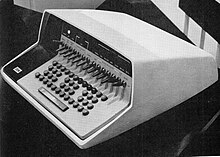This article includes a list of references, related reading, or external links, but its sources remain unclear because it lacks inline citations. (February 2010) |
The IBM 610 Auto-Point Computer is one of the first personal computers, in the sense of a computer to be used by one person whose previous experience with computing might only have been with desk calculators. It was controlled interactively by a keyboard. The principal designer of this machine was John Lentz, as part of his work for the Watson Lab at Columbia University.
 Control unit of the IBM 610 with keyboard | |
| Also known as | IBM 610 Auto-Point Computer |
|---|---|
| Developer | John Lentz, as part of his work for the Watson Lab at Columbia University |
| Manufacturer | IBM |
| Type | Personal computer |
| Release date | 1957 |
| Introductory price | $55,000 (or rented for $1150 per month ($460 academic)) |
| Units shipped | 180 |
| Removable storage | Punched paper tape |
| Mass | 800 pounds (360 kg) |
| Successor | IBM 1620 |
The IBM 610 was introduced in 1957.[1][2] It was small enough to easily fit in an office; it weighed about 800 pounds (360 kg).[3] It was designed to be used in a normal office, without any special electrical or air conditioning requirements. It used vacuum tubes, a magnetic drum, and punched paper tape readers and punchers. The input was from a keyboard and output was to an IBM electric typewriter, at eighteen characters per second. It was one of the first computers to be controlled from a keyboard. The term "auto-point" referred to the ability to automatically adjust the decimal point in floating-point arithmetic.
Its price was $55,000, or it could be rented for $1150 per month ($460 academic). 180 units were made. It was a slow and limited computer, and was generally replaced by the IBM 1620.
See also
editReferences
edit- ^ Inc, Ziff Davis (1984-03-06). PC Mag. Ziff Davis, Inc. p. 84.
{{cite book}}:|last=has generic name (help) - ^ Peddie, Jon (2013-06-13). The History of Visual Magic in Computers: How Beautiful Images are Made in CAD, 3D, VR and AR. Springer Science & Business Media. p. 176. ISBN 9781447149323.
- ^ Weik, Martin H. (Mar 1961). "IBM 610". ed-thelen.org. A Third Survey of Domestic Electronic Digital Computing Systems.
External links
edit- The IBM 610 Auto-Point Computer
- IBM 610 Autopoint Computer 1961 BRL report
- IBM Archives: IBM 610 — Auto-Point Computer
- "IBM 610 documents". www.bitsavers.org.